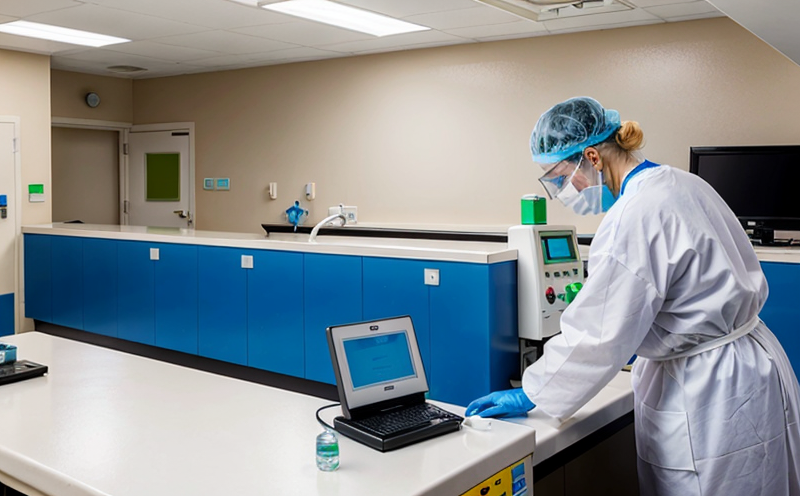Steam Sterilizer Validation Testing in Central Sterile Services
In hospital hygiene and environmental monitoring testing, steam sterilizers play a critical role in ensuring the safety and efficacy of medical devices used in healthcare settings. The process of validating these sterilizers is essential to meet regulatory standards and ensure consistent sterility assurance. This section provides an in-depth overview of Steam Sterilizer Validation Testing performed specifically for central sterile services.
The validation process involves several key phases aimed at demonstrating that the steam sterilizer meets all requirements set forth by international standards such as ISO 17665-2. This includes validating the sterilization cycles, monitoring and recording temperature, pressure, and time parameters, and ensuring the effectiveness of the sterilization cycle through biobarrier testing.
Central Sterile Services (CSS) departments are responsible for preparing, processing, packaging, storing, and distributing sterile supplies to healthcare facilities. The steam sterilizer is a critical component in this process as it ensures that instruments and medical devices are free from microorganisms before being used on patients. Proper validation of the steam sterilizer helps to prevent cross-contamination, infection, and other adverse events.
During the validation process, CSS staff must adhere to strict protocols for specimen preparation, instrument handling, and cycle monitoring. This ensures that the results obtained are accurate and reliable. The testing is typically conducted by a certified laboratory equipped with state-of-the-art equipment capable of performing precise measurements and data recording.
The primary goal of steam sterilizer validation testing in CSS is to provide evidence that the sterilization process consistently produces sterile conditions under defined parameters. This includes ensuring that all parts of the load reach the required temperature, pressure, and time for a sufficient duration to achieve sterility. The results of these tests are essential for maintaining compliance with healthcare regulations and ensuring patient safety.
Central Sterile Services personnel must also be trained in proper sterilizer operation and validation procedures. This includes understanding the importance of cycle setup, load preparation, and monitoring during each cycle. Regular maintenance and calibration of the sterilizer are necessary to ensure optimal performance throughout its operational lifecycle.
Why It Matters
The validation process for steam sterilizers in CSS is critical because it directly impacts patient safety and overall healthcare outcomes. Ensuring that instruments are properly sterilized before use reduces the risk of hospital-acquired infections (HAIs), which can lead to prolonged hospital stays, increased morbidity rates, and higher mortality risks.
ISO 17665-2 specifies detailed requirements for validating steam sterilizers used in healthcare settings. Adherence to these standards not only ensures compliance with regulatory bodies but also demonstrates a commitment to quality assurance within the organization. By implementing rigorous validation protocols, CSS departments can build trust among patients and staff while maintaining high standards of care.
Regular validation testing allows CSS teams to identify any potential issues early on, enabling timely corrective actions that prevent costly downtime or reprocessing of contaminated items. Additionally, accurate documentation provides valuable insights into the sterilization process, helping facilities optimize their procedures for maximum efficiency and effectiveness.
In summary, steam sterilizer validation testing is vital for maintaining the integrity of CSS operations and ensuring patient safety. It serves as a critical step in preventing contamination, reducing HAIs, and upholding industry best practices.
Customer Impact and Satisfaction
The implementation of robust steam sterilizer validation testing has significant positive impacts on both patients and healthcare providers. Patients benefit from reduced risks associated with contaminated medical devices, leading to improved recovery times and better overall health outcomes. For healthcare providers, validated sterilization processes enhance operational efficiency by minimizing reprocessing needs and ensuring consistent quality across all procedures.
By adhering to strict validation protocols, CSS departments can demonstrate their commitment to patient safety and regulatory compliance, thereby enhancing customer satisfaction and trust within the facility. This dedication also contributes to a culture of continuous improvement, fostering an environment where best practices are continuously refined and updated based on evolving standards and feedback from stakeholders.
Regular communication between CSS teams and other hospital departments ensures that all parties remain informed about the latest developments in sterilization technology and methodologies. Such collaboration facilitates seamless integration of validated procedures into daily workflows, further supporting overall quality initiatives within the organization.
Use Cases and Application Examples
| Use Case | Description |
|---|---|
| Initial Validation | This involves conducting a series of cycles under different conditions to establish baseline performance metrics. These include testing at minimum, nominal, and maximum load sizes along with various combinations of instruments. |
| Cycle Repetition Testing | After initial validation, continuous monitoring through repeated cycle tests helps maintain consistent performance over time. This ensures that the sterilizer continues to meet required standards even after extended use. |
| Biobarrier Testing | Testing with bioloads simulates real-world scenarios where pathogens may be present on instruments, verifying whether the sterilization cycle can eliminate them effectively. |
| Load Configuration Studies | Exploring different configurations of loads helps determine optimal packing methods and positions within the sterilizer chamber to ensure even heat distribution. |
| Use Case | Description |
|---|---|
| Cycle Parameter Optimization | Analyzing cycle parameters such as temperature, pressure, and time allows for fine-tuning of settings to achieve optimal results while minimizing energy consumption. |
| Environmental Monitoring | Monitoring the surrounding environment ensures that conditions are conducive to effective sterilization. This includes checking humidity levels and ensuring proper ventilation. |
| Packaging Material Evaluation | Evaluating different types of packaging materials helps identify those most suitable for maintaining sterility during transport and storage. |
| Employee Training Programs | Providing comprehensive training programs ensures that all CSS staff are well-versed in proper sterilizer operation and validation procedures. |





